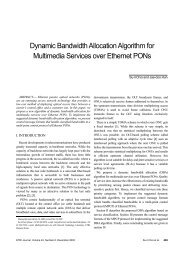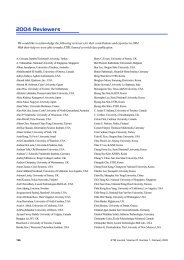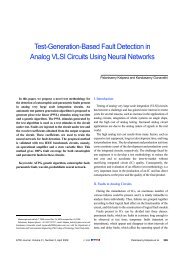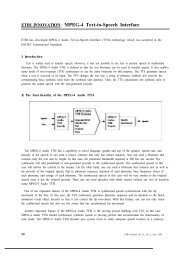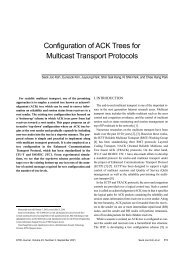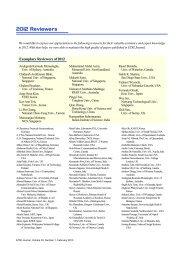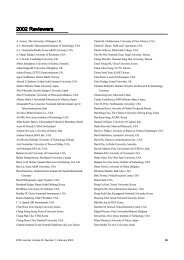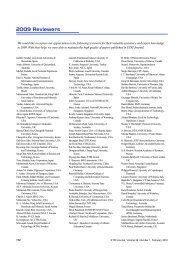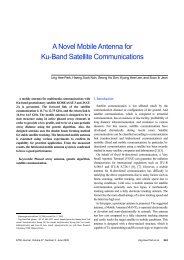Extraction of Passive Device Model Parameters ... - ETRI Journal
Extraction of Passive Device Model Parameters ... - ETRI Journal
Extraction of Passive Device Model Parameters ... - ETRI Journal
You also want an ePaper? Increase the reach of your titles
YUMPU automatically turns print PDFs into web optimized ePapers that Google loves.
<strong>Extraction</strong> <strong>of</strong> <strong>Passive</strong> <strong>Device</strong> <strong>Model</strong> <strong>Parameters</strong><br />
Using Genetic Algorithms<br />
Ilgu Yun a) , Lawrence A. Carastro, Ravi Poddar, Martin A. Brooke, Gary S. May, Kyung-Sook Hyun, and Kwang Eui Pyun<br />
The extraction <strong>of</strong> model parameters for embedded passive<br />
components is crucial for designing and characterizing<br />
the performance <strong>of</strong> multichip module (MCM) substrates.<br />
In this paper, a method for optimizing the extraction <strong>of</strong><br />
these parameters using genetic algorithms is presented.<br />
The results <strong>of</strong> this method are compared with optimization<br />
using the Levenberg-Marquardt (LM) algorithm used in<br />
the HSPICE circuit modeling tool. A set <strong>of</strong> integrated resistor<br />
structures are fabricated, and their scattering parameters<br />
are measured for a range <strong>of</strong> frequencies from 45 MHz to 5<br />
GHz. Optimal equivalent circuit models for these structures<br />
are derived from the s-parameter measurements using each<br />
algorithm. Predicted s-parameters for the optimized equivalent<br />
circuit are then obtained from HSPICE. The difference<br />
between the measured and predicted s-parameters in the<br />
frequency range <strong>of</strong> interest is used as a measure <strong>of</strong> the accuracy<br />
<strong>of</strong> the two optimization algorithms. It is determined<br />
that the LM method is extremely dependent upon the initial<br />
starting point <strong>of</strong> the parameter search and is thus prone to<br />
become trapped in local minima. This drawback is alleviated<br />
and the accuracy <strong>of</strong> the parameter values obtained is<br />
improved using genetic algorithms.<br />
Manuscript received November 27, 1999; revised January 20, 2000.<br />
a) Electronic mail: iyun@etri.re.kr<br />
I. INTRODUCTION<br />
As electronics technology continues to develop, there is a<br />
continuous need for higher levels <strong>of</strong> system integration and<br />
miniaturization. For example, in many applications, it is desirable<br />
to package several integrated circuits (ICs) together in<br />
multichip modules (MCMs) to achieve further compactness and<br />
higher performance. <strong>Passive</strong> components (i.e., capacitors, resistors,<br />
and inductors) are an essential requirement for many<br />
MCM applications [1]. A significant advantage <strong>of</strong> MCM technology<br />
is the ability to embed large numbers <strong>of</strong> these passive<br />
components directly into the substrate at low cost. Such an arrangement<br />
provides further advantages in component miniaturization,<br />
power consumption, reliability, and performance.<br />
It is common for high frequency systems to include filters<br />
with specifications into the gigahertz range. In order to successfully<br />
design passive filters at such high frequencies, the behavior<br />
<strong>of</strong> the passive components that comprise the filter must be<br />
modeled accurately up to those frequencies. Recently, computeraided<br />
design tools such as HSPICE [2] have become indispensable<br />
in IC design. Accurate circuit simulation using HSPICE<br />
is dependent on both the validity <strong>of</strong> the device models and the<br />
accuracy <strong>of</strong> the values used as model parameters. Therefore,<br />
the extraction <strong>of</strong> an optimum set <strong>of</strong> device model parameter<br />
values is crucial to characterizing the precise relationship between<br />
the device model and the measured behavior. Even if the structure<br />
<strong>of</strong> a model is valid, it could lead to poor simulation results if<br />
model parameters are not extracted properly.<br />
In this paper, a method for optimizing the extraction <strong>of</strong> these<br />
parameters using genetic algorithms (GAs) is presented [3]. GAs<br />
are a set <strong>of</strong> guided stochastic search procedures based loosely on<br />
the principles <strong>of</strong> genetics. To investigate the use <strong>of</strong> GAs for the<br />
optimization <strong>of</strong> parameter extraction in passive devices operated<br />
38 Ilgu Yun et al. <strong>ETRI</strong> <strong>Journal</strong>, Volume 22, Number 1, March 2000
at high frequencies, a set <strong>of</strong> integrated passive structures were<br />
fabricated, and their scattering parameters were measured for a<br />
range <strong>of</strong> frequencies from 45 MHz to 5 GHz. Optimal equivalent<br />
circuit models for these structures were derived from the s-<br />
parameter measurements. Predicted s-parameters for the optimized<br />
equivalent circuit were then obtained from HSP ICE.<br />
The difference between the measured and predicted s-<br />
parameters in the frequency range <strong>of</strong> interest is used as the measure<br />
<strong>of</strong> the accuracy <strong>of</strong> the optimization results.<br />
Conventional optimization techniques such as the Levenberg-Marquardt<br />
(LM) method [4], which is used by HSPICE<br />
for parameter extraction, are <strong>of</strong>ten subject to becoming trapped<br />
in local minima, leading to suboptimal parameter values.<br />
GAs represent an effective method for determining the global<br />
minimum and are less dependent upon the initial starting point<br />
<strong>of</strong> the search. Here, we compare optimization using the LM algorithm<br />
to optimization using GAs. It is determined that drawbacks<br />
<strong>of</strong> the LM method are alleviated, and the accuracy <strong>of</strong> the<br />
parameter values obtained is improved using GAs.<br />
Probe Pad<br />
Probe Pad<br />
20 Uncoupled Line Building Blocks<br />
...<br />
(a)<br />
(b)<br />
Shielded Stub<br />
Probe Pad<br />
10 Uncoupled Line Building Blocks<br />
II. TEST STRUCTURE DESCRIPTION<br />
Three different types <strong>of</strong> passive devices were considered in<br />
this study. These test structures are shown in Fig. 1. The first<br />
structure is simply a straight-line resistor with probe pads on its<br />
ends. This structure is needed to characterize basic uncoupled<br />
material parameters including self resistance, inductance, and<br />
capacitance. The second test structure is an interdigitated capacitor.<br />
This type <strong>of</strong> device is used in a wide variety <strong>of</strong> circuits,<br />
including resonators, oscillators, and filters to perform functions<br />
such as DC blocking, frequency filtering and impedance<br />
transformation. The final test structure is a three-dimensional<br />
solenoid inductor made using a low-temperature c<strong>of</strong>ired ceramic<br />
(LTCC) process [1], [5].<br />
The resistor and capacitor test structures were built using<br />
Ti/Au deposited on a 96 % alumina substrate. An electron beam<br />
evaporation system was used to deposit 0.04 um <strong>of</strong> titanium<br />
followed by a 0.2 um layer <strong>of</strong> gold. The thin layer <strong>of</strong> titanium<br />
was used to improve adhesion <strong>of</strong> the gold to the substrate.<br />
Following deposition, the resistors were defined using standard<br />
photolithography and etch back techniques. The photoresist<br />
was hard-baked for five minutes at 125 °C in order to stabilize it<br />
before etching. The gold was etched in a heated KCN solution<br />
for one minute, followed by a buffered oxide etch to remove<br />
the titanium. Due to the surface roughness <strong>of</strong> the substrate (approximately<br />
+/− 1.5 um), the edges <strong>of</strong> the resistor were jagged,<br />
but the lines were continuous. All processing was done at the<br />
Georgia Tech Microelectronics Research Center.<br />
The LTCC inductor structure was designed within the Cadence<br />
Virtuoso design environment. A custom technology file<br />
(c)<br />
Fig.1. Schematic three test structures: (a) straight-line resistor;<br />
(b) interdigitated capacitor; and (c) LTCC inductor.<br />
for a 12-layer process was developed, and a process design rule<br />
compliant test structure coupon was fabricated at the National<br />
Semiconductor Corporation LTCC fabrication facility. The size<br />
<strong>of</strong> the completed coupon was approximately 2.25" × 2.25".<br />
Each layer <strong>of</strong> ceramic tape was specified to be 3.6 mils thick<br />
with a dielectric constant <strong>of</strong> 7.8. The metal lines were drawn to<br />
be 10 mils wide, and the vias were a diameter <strong>of</strong> 5.6 mils.<br />
III. MODELING SCHEME<br />
High frequency analysis <strong>of</strong> complex geometrical structures is<br />
required to investigate their electrical performance in a frequency<br />
range <strong>of</strong> interest. This analysis is especially important to determine<br />
the effects <strong>of</strong> unwanted spurious couplings and resonances which<br />
can greatly affect the overall system response. Analysis such as this<br />
is usually only achievable through the use <strong>of</strong> electromagnetic or<br />
RF/microwave simulation tools. The derivation <strong>of</strong> equivalent circuit<br />
models is very useful to designers who would<br />
<strong>ETRI</strong> <strong>Journal</strong>, Volume 22, Number 1, March 2000 Ilgu Yun et al. 39
1 2<br />
Probe Pad Building Block<br />
R_pad = 0.1E-3 Ohm<br />
L_pad = 0.2E-10 H<br />
C_pad = 0.1E-14 F<br />
Uncoupled LineBuilding Block<br />
1 2<br />
C_cou = 1.2E-15 F<br />
R_pad = 0.08 Ohm<br />
L_pad = 1E-11 H<br />
C_pad = 2.7E-15 F<br />
1 2<br />
1 2<br />
(a)<br />
Probe Pad Building Block<br />
1 2<br />
Uncoupled LineBuilding Block<br />
1 2<br />
Shielded Stub Building Block<br />
1<br />
2<br />
3<br />
2<br />
1 3<br />
1 2<br />
1 2<br />
R_pad = 0.08 Ohm<br />
L_pad = 1.2E-11 H<br />
C_pad = 3.6E-15 F<br />
C_cou = 1.2E-15 F<br />
R_pad = 0.07 Ohm<br />
L_pad = 1E-11 H<br />
C_pad = 2.9E-15 F<br />
C2 = 3.3E-15 F<br />
R = 0.6 Ohm<br />
L = 1E-10 H<br />
C = 7.1E-15 F<br />
(b)<br />
Probe Pad Building Block<br />
Uncoupled LineBuilding Block<br />
1<br />
1 2<br />
2<br />
R_pad = 1E-3 Ohm<br />
L_pad = 1.8e-10 H<br />
C_pad = 3.1e-13 F<br />
1 2<br />
C_cou = 1.2E-15 F<br />
R_pad = 1E-3 Ohm<br />
L_pad = 8.3E-11 H<br />
C_pad = 2.8E-14 F<br />
1 2<br />
(c)<br />
Fig. 2. Building blocks with associated circuit topologies and model parameters for (a) the straight-line resistor; (b) the interdigitated<br />
capacitor; and (c) the LTCC inductor.<br />
40 Ilgu Yun et al. <strong>ETRI</strong> <strong>Journal</strong>, Volume 22, Number 1, March 2000
like to incorporate the complex behavior <strong>of</strong> these structures in a<br />
system level circuit simulation. However, the process <strong>of</strong> obtaining<br />
lumped models from these simulators is a slow and computationally<br />
challenging task.<br />
The modeling procedure implemented here involves determining<br />
a set <strong>of</strong> fundamental building blocks for the passive<br />
structures and then characterizing test structures comprised <strong>of</strong><br />
combinations <strong>of</strong> those blocks [6]. The test structures are measured<br />
up to a desired frequency, and the electrical contribution to<br />
the overall response by the building blocks can then be determined.<br />
Equivalent circuits <strong>of</strong> each <strong>of</strong> the building blocks are<br />
then extracted using a hierarchical extraction procedure that<br />
will be described. Simulation <strong>of</strong> the derived circuit in a standard<br />
SPICE-compatible circuit simulator then provides the desired<br />
prediction <strong>of</strong> electrical behavior. Test structure models are verified<br />
experimentally by comparing the predicted electrical response<br />
with the measured response.<br />
1. Test Structure Characterization<br />
The test structures described in Section II above were measured<br />
using standard network analysis techniques. For high frequency<br />
measurements, an HP 8,510 C network analyzer was<br />
used in conjunction with a Cascade Microtech probe station<br />
and ground-signal-ground configuration probes. Calibration<br />
was accomplished using a supplied substrate and the linereflect-match<br />
(LRM) calibration method. After calibration was<br />
completed, s-parameters were obtained for each <strong>of</strong> the test<br />
structures at 201 frequency points between 45 MHz and 5 GHz.<br />
This data was stored with the aid <strong>of</strong> computer data acquisition<br />
s<strong>of</strong>tware and equipment.<br />
2. <strong>Device</strong> <strong>Model</strong> Parameter <strong>Extraction</strong><br />
For passive device structures, it is desirable to predict their<br />
electrical behavior in a standard circuit simulator. In order to<br />
accomplish this, circuit models for each <strong>of</strong> the defined building<br />
blocks need to be extracted. The fundamental circuit for the<br />
building blocks is based on the partial element equivalent circuit<br />
(PEEC) [7] which has been used extensively for interconnect<br />
analysis [8] and general three-dimensional high frequency<br />
structure simulation [9]. Coupling behavior is represented by<br />
the coupling capacitance between center nodes <strong>of</strong> the two<br />
PEEC circuits, as well as by mutual inductances between the<br />
left upper and left lower branch inductors in the model, and<br />
likewise for the right hand side. These circuits represent models<br />
for the building blocks only. The test structure circuits are comprised<br />
<strong>of</strong> many <strong>of</strong> the building block circuits connected in accordance<br />
with the structure geometry. The various circuit models<br />
and parameters for the different building blocks are shown<br />
in Fig. 2.<br />
After the circuit models for the different building blocks<br />
were obtained, the extraction <strong>of</strong> the circuit model parameters<br />
was achieved using two different optimization techniques. The<br />
first method chosen was the Levenberg-Marquardt (LM) algorithm<br />
[10]. Since the LM algorithm is built into HSPICE, all<br />
LM-based optimization and simulations were done using the<br />
HSPICE simulator on a Sun Sparc 20 workstation. Since the<br />
starting point or initial guesses for the circuit parameters were<br />
crucial for achieving convergence, an initial optimization was<br />
done assuming that each test structure was comprised <strong>of</strong> just<br />
one building block, utilized repetitively across the length <strong>of</strong> the<br />
structure on a per square basis. The initial guesses for the circuit<br />
parameters were derived by converting the measured s-<br />
parameters to z-parameters, and then dividing by the number <strong>of</strong><br />
blocks used in order to extract the valid R, L, and C, values for<br />
the circuit model. Figure 3 shows a flow chart for the s-<br />
parameter extraction procedure.<br />
However, since small changes in the initial guesses <strong>of</strong>ten led<br />
to non-convergence or incorrect optimization results, another<br />
optimization method which used genetic algorithms (GAs) was<br />
investigated. GA optimization was performed by s<strong>of</strong>tware written<br />
in ANSI standard C++, and was compiled for use in the<br />
UNIX environment. HSPICE circuit simulations were still<br />
needed to obtain s-parameter data to complete GA optimization.<br />
GAs represent a guided stochastic approach to optimization<br />
which establishes a parallel search <strong>of</strong> the solution space. Since<br />
GAs use a large population <strong>of</strong> trial solutions, they can explore<br />
many regions <strong>of</strong> the search space simultaneously. Therefore,<br />
GAs are insensitive to initial guesses, and they are less likely to<br />
become trapped in local optima compared to conventional<br />
optimization methods. Further details on both the LM algorithm<br />
and GAs are provided in the following section.<br />
IV. PARAMETER OPTIMIZATION METHODS<br />
The equivalent circuit model parameter values required by<br />
the HSPICE simulator are usually obtained by curve fitting the<br />
model equations to device measured data. This curve fitting is<br />
accomplished using nonlinear least squares optimization techniques.<br />
Optimization is the process by which the set <strong>of</strong> model<br />
parameter values which best fit the data are selected. This optimum<br />
parameter set is created by adjusting an initial estimate<br />
<strong>of</strong> model parameter values using an iterative process. The<br />
process continues until simulated output data matches the actual<br />
measured output data within specified tolerances. In short,<br />
given a set <strong>of</strong> measured data, the optimizer solves for a set <strong>of</strong><br />
model parameters which produce simulated data that optimally<br />
approximates the measured data.<br />
<strong>ETRI</strong> <strong>Journal</strong>, Volume 22, Number 1, March 2000 Ilgu Yun et al. 41
Define test structure geometry and<br />
building blocks<br />
Fabricate test structures<br />
Measure s-parameters for test structure<br />
purely gradient descent when the Marquardt scaling parameter<br />
is very large, whereas the LM method is equivalent to the<br />
Gauss-Newton method when the Marquardt scaling parameter<br />
is zero.<br />
The objective function <strong>of</strong> LM algorithm is<br />
⎡ ( ) − ⎤<br />
( ) = ( 1,<br />
2 ,...,<br />
) = ∑<br />
m<br />
i<br />
fi<br />
X Fmeas<br />
Fo<br />
X X x x x ⎢wi<br />
i ⎥ (1)<br />
n<br />
i=<br />
1 ⎣ Fmeas<br />
⎦<br />
2<br />
Extract circuit models for each building<br />
blocks using PEEC<br />
<strong>Device</strong> <strong>Model</strong> Parameter Optimization<br />
1) LM algorithm<br />
2) Genetic Algorithms<br />
Obtain device model parameters<br />
Simulate s-parameters<br />
using HSPICE<br />
Fig. 3. Flow chart for s-parameter extraction.<br />
1. Levenberg-Marquardt Algorithm<br />
The optimization method used in the HSPICE simulator is<br />
the well-known Levenberg-Marquardt (LM) algorithm implemented<br />
with the Marquardt scaling parameter to prevent unexpected<br />
deviation <strong>of</strong> the parameter values. The LM search<br />
method is a combination <strong>of</strong> steepest descent and the Gauss-<br />
Newton method.<br />
Gradient descent is a commonly used search method where<br />
parameters are moved in the opposite direction to the error gradient.<br />
Each step down the gradient results in smaller errors until<br />
minimum error is achieved. However, simple gradient descent<br />
suffers from slow convergence, in particular when a minimum<br />
is approached. Another commonly used method is the gradient<br />
with momentum that updates parameters proportionally to a<br />
running average <strong>of</strong> the gradient. In general, this technique can<br />
decrease the probability <strong>of</strong> becoming trapped in local minima.<br />
Nevertheless, the final iterations <strong>of</strong> the gradient with momentum<br />
method are still not effective when approaching a solution.<br />
The Gauss-Newton method provides better convergence properties<br />
near the solution. However, at a point away from the solution,<br />
this method suffers from the fact that prescribed the direction<br />
may not be a descent direction, and the associated inverted<br />
Hessian matrix may not exist.<br />
In the LM algorithm, steepest descent is used initially to approach<br />
the solution, and then the Gauss-Newton method is used<br />
to refine the solution. During this search, the Marquardt scaling<br />
parameter becomes very small, but increases if the solution starts<br />
to deviate. If this happens, the LM technique optimizer becomes<br />
where X = (x 1 , x 2 , ..., x n ) are the model parameters to be extracted,<br />
n is the total number <strong>of</strong> the model parameters, F i meas is<br />
the measured value <strong>of</strong> the ith model parameter, m is the total<br />
number <strong>of</strong> measurements, f i (X) is the simulated value <strong>of</strong> the ith<br />
point, and w i is a weight factor for the ith measured data point<br />
(used for giving higher significance to a given data point).<br />
Therefore, the HSPICE optimizer finds the vector X <strong>of</strong> the device<br />
model parameters that minimizes F o (X).<br />
2. Genetic Algorithms<br />
Genetic algorithms (GAs) refer to a family <strong>of</strong> computational<br />
models inspired by evolution. In the last few years, GAs have<br />
started to be explored for several applications in industry [11],<br />
[12]. These algorithms encode a potential solution to a specific<br />
problem on a simple chromosome-like binary data structure<br />
and apply recombination operators to these structures so as to<br />
preserve critical information. An implementation <strong>of</strong> a genetic<br />
algorithm begins with a population <strong>of</strong> (typically random)<br />
chromosomes. To implement a GA, the set <strong>of</strong> parameters to be<br />
optimized are first mapped onto a set <strong>of</strong> binary strings, with<br />
each string representing a potential solution. The GA then manipulates<br />
the most promising strings in searching for improved<br />
solutions. A GA typically operates iteratively through a simple<br />
cycle <strong>of</strong> four stages: 1) creation <strong>of</strong> a population <strong>of</strong> strings, 2)<br />
evaluation <strong>of</strong> each string, 3) selection <strong>of</strong> the best strings, and 4)<br />
genetic manipulation to create a new population <strong>of</strong> strings. The<br />
process for optimizing passive device model parameters using<br />
GAs is shown in Fig. 4.<br />
The genetic manipulation includes three genetic operations<br />
—reproduction, crossover, and mutation—to search the optimal<br />
solution in the entire search space. Using these operations, GAs<br />
can search through large, irregularly shaped spaces effectively,<br />
requiring only the information <strong>of</strong> the objective function. This is<br />
a desirable characteristic, considering that the majority <strong>of</strong> commonly<br />
used search techniques require not only the complete information<br />
<strong>of</strong> the objective function but also derivative information,<br />
continuity <strong>of</strong> the search space.<br />
In coding genetic searches, binary strings are typically used.<br />
One successful method for coding multiparameter optimization<br />
problems is concatenated, multiparameter, mapped, fixed-point<br />
42 Ilgu Yun et al. <strong>ETRI</strong> <strong>Journal</strong>, Volume 22, Number 1, March 2000
Initial population<br />
P1<br />
1 0 0 0 1 1<br />
O1<br />
1 0 0 0 0 0<br />
Measure model <strong>Parameters</strong><br />
HSPICE Simulation<br />
Simulate model <strong>Parameters</strong><br />
crossover point<br />
P2<br />
0 1 1 1 0 0<br />
crossover point<br />
O2<br />
0 1 1 1 1 1<br />
Error<br />
Criteria ?<br />
yes<br />
Fig. 6. Illustration <strong>of</strong> the crossover operation.<br />
no<br />
Genetic Algorithms<br />
- Reproduction<br />
- Crossover<br />
- Mutation<br />
Extract device model<br />
parameters<br />
1 0 1 1 0 1<br />
1 0 1 1 1 1<br />
Generate new population<br />
Fig.7. Illustration <strong>of</strong> the mutation operation.<br />
Fig. 4. Optimization process for device model parameters using GAs.<br />
1 0 1 1 0 1 1 1<br />
1st parameter = 4.2<br />
range [2, 5]<br />
precision = 0.2<br />
2nd parameter = 7<br />
range [0, 15]<br />
precision = 1<br />
Fig. 5. Example <strong>of</strong> multiparameter coding.<br />
coding [3]. If x ∈ [0, 2 b ] is the parameter <strong>of</strong> interest (where b is<br />
the number <strong>of</strong> bits in the string), the decoded unsigned integer<br />
x can be mapped linearly from [0,2 b ] to a specified interval<br />
[U min , U max ]. In this way, both the range and precision <strong>of</strong> the<br />
decision variables can be controlled. To construct a multiparameter<br />
coding, required single parameters can simply be<br />
concatenated. Each coding may have its own sub-length (i.e.,<br />
its own U min and U max ). Figure 5 shows an example <strong>of</strong> a 2-<br />
parameter coding with four bits in each parameter. The ranges<br />
<strong>of</strong> the first and second parameters are 2-5 and 0-15, respectively.<br />
The string manipulation process employs the aforementioned<br />
genetic operators to produce a new population <strong>of</strong> individuals<br />
(called <strong>of</strong>fspring) by modifying the genetic code possessed<br />
by members <strong>of</strong> the current population (called parents).<br />
Reproduction is the process by which strings with high fitness<br />
values (i.e., good solutions to the optimization problem under<br />
consideration) receive larger numbers <strong>of</strong> copies in the new<br />
population. A popular method <strong>of</strong> reproduction is elitist roulette<br />
wheel selection [13]. In this method, those strings with large<br />
fitness values F i are assigned a proportionately higher probability<br />
<strong>of</strong> survival into the next generation. This probability distribution<br />
is determined according to<br />
P<br />
select i<br />
= n<br />
F<br />
∑<br />
i<br />
j = 1<br />
Thus, an individual string whose fitness is n times better than<br />
another will produce n times the number <strong>of</strong> <strong>of</strong>fspring in the<br />
subsequent generation. Once the strings have reproduced, they<br />
are stored in a mating pool awaiting the actions <strong>of</strong> the crossover<br />
and mutation operators.<br />
The crossover operator takes two chromosomes and interchanges<br />
part <strong>of</strong> their genetic information to produce two new<br />
chromosomes (Fig. 6). After the crossover point has been randomly<br />
chosen, portions <strong>of</strong> the parent strings (P1 and P2) are<br />
swapped to produce the new <strong>of</strong>fspring (O1 and O2) based<br />
upon a specified crossover probability. Mutation is motivated<br />
by the possibility that the initially defined population might not<br />
contain all <strong>of</strong> the information necessary to solve the problem.<br />
This operation is implemented by randomly changing a fixed<br />
number <strong>of</strong> bits every generation based upon a specified mutation<br />
probability (Fig. 7). Typical values for the probabilities <strong>of</strong><br />
crossover and bit mutation range from 0.6 to 0.95 and 0.001 to<br />
0.01, respectively. Higher mutation and crossover rates disrupt<br />
good “building blocks” (schemata) more <strong>of</strong>ten, and for smaller<br />
populations, sampling errors tend to wash out the predictions.<br />
For this reason, the greater the mutation and crossover rates and<br />
the smaller the population size, the less frequently predicted<br />
F<br />
(2)<br />
<strong>ETRI</strong> <strong>Journal</strong>, Volume 22, Number 1, March 2000 Ilgu Yun et al. 43
Table 1. Genetic algorithm parameters.<br />
<strong>Parameters</strong><br />
Value<br />
Crossover Probability 0.9<br />
Mutation Probability 0.01<br />
Population Size 8<br />
Chromosome Length<br />
80 bits<br />
solutions are confirmed.<br />
In this study, the genetic algorithms have been implemented<br />
to extract the passive device circuit model parameters for the<br />
test structures described above using the following fitness function<br />
(F fit ):<br />
1<br />
=<br />
1+ ∑ −<br />
Ffit<br />
2<br />
( ymeas<br />
ysim<br />
)<br />
n<br />
where n is the number <strong>of</strong> s-parameter measurements taken,<br />
y meas are the actual s-parameter measurements, and y sim are the<br />
simulated s-parameters found using HSPICE. The probabilities<br />
<strong>of</strong> crossover and mutation were set to 0.9 and 0.01, respectively<br />
(see Table 1). A population size <strong>of</strong> 8 was used in each generation.<br />
Each <strong>of</strong> the eight device model parameters were encoded<br />
as a 10-bit string, resulting in a total chromosome length <strong>of</strong> 80<br />
bits. The optimization procedure was stopped after 100 iterations<br />
or when F fit was within a predefined tolerance.<br />
V. RESULTS AND DISCUSSION<br />
The optimization results using the LM algorithm in the<br />
HSPICE optimizer and GAs for the three test structures described<br />
in Section II are presented here. Each structure requires<br />
the extraction <strong>of</strong> eight passive device values from s-parameter<br />
measurements. The root mean square error (RMSE) between<br />
the measured and simulated s-parameters has been calculated<br />
for each optimization method.<br />
For the extraction <strong>of</strong> the passive device model parameters in the<br />
straight-line resistor, 20 different sets <strong>of</strong> parameters were used as<br />
the initial starting points for the LM algorithm. These initial sets <strong>of</strong><br />
parameters were randomly selected using 10 % deviation from a<br />
previously analyzed set <strong>of</strong> parameters which had converged to a<br />
solution. Among the 20 simulations, only three converged to a solution.<br />
Table 2 shows the results <strong>of</strong> extracting the passive device<br />
model parameters for the straight line resistor using the LM algorithm<br />
and GAs. The results illustrate that the LM algorithm can be<br />
trapped in local minima, and the use <strong>of</strong> GAs can improve the accuracy<br />
<strong>of</strong> the model parameter values.<br />
(3)<br />
Table 2. Optimization results for the straight-line resistor.<br />
HSPICE Optimizer results<br />
GA result<br />
Parameter run1 run2 run3 GA_run<br />
C_cou 1.52E−14 1.63E−13 5.15E−14 2.19E−14<br />
Rsq 5.38E−02 1.00E−02 3.04E−02 4.83E−02<br />
Lsq 1.13E−15 9.36E−12 9.36E−12 9.32E−12<br />
Csq 2.72E−15 2.59E−16 2.61E−15 2.70E−15<br />
C_cou2 1.00E−15 6.23E−11 7.75E−11 9.22E−11<br />
R2sq 9.85E−02 1.37E−01 1.15E−01 9.80E−02<br />
L2sq 8.88E−12 1.15E−12 1.03E−12 9.32E−13<br />
C2sq 3.35E−17 2.46E−15 8.98E−17 1.20E−17<br />
RMSE 1.50E−03 1.40E−03 1.40E−03 1.20E−03<br />
Table 3. Optimization results for the interdigitated capacitor.<br />
HSPICE Optimizer results<br />
GA result<br />
Parameter run1 run2 run3 run4 GA_run<br />
C_cou 1.00E−15 1.00E−15 1.00E−15 1.00E−09 4.40E−16<br />
R_pad 1.54E−01 1.50E−01 1.59E−01 1.70E−01 5.67E−02<br />
L_pad 1.54E−11 1.50E−11 1.59E−11 1.20E−11 8.99E−11<br />
C_pad 3.54E−15 3.50E−15 3.59E−15 3.20E−15 3.59E−15<br />
Rsq 1.55E−01 1.55E−01 1.55E−01 1.39E−01 1.88E−01<br />
Lsq 8.87E−12 8.87E−12 8.87E−12 9.15E−12 9.42E−12<br />
Csq 2.76E−15 2.76E−15 2.76E−15 2.25E−15 2.51E−15<br />
RMSE 1.13E−03 1.58E−03 1.29E−03 2.03E−03 5.81E−04<br />
Similar results were found for the interdigitated capacitor test<br />
structure (see Table 3). In this case, 30 sets <strong>of</strong> randomly generated<br />
initial model parameters were used for the LM algorithm,<br />
and a solution was found for only four <strong>of</strong> these. The model parameter<br />
values found using GAs were much more accurate<br />
compared those found by means <strong>of</strong> the LM method.<br />
Table 4 shows the results <strong>of</strong> extracting the passive device<br />
model parameters for the LTCC inductor. In this case, 20 sets<br />
<strong>of</strong> randomly generated initial model parameters were used for<br />
the LM algorithm, and a solution was found for ten <strong>of</strong> these<br />
cases. From these results, it was found that the LM algorithm<br />
yields a large variation in the extracted model parameters.<br />
For example, C_cou varies from 10 −15 to 10 −10 F, and Rsq varies<br />
from 10 −3 to 10 −6 ohms. However, since GAs can explore<br />
the search space more effectively, a single solution representing<br />
the global optimum is found using this method.<br />
44 Ilgu Yun et al. <strong>ETRI</strong> <strong>Journal</strong>, Volume 22, Number 1, March 2000
Table 4. Optimization results for the LTCC inductor.<br />
HSPICE Optimizer results<br />
GA result<br />
Parameter run1 run2 run3 run4 run5 run6 run7 run8 run9 run10 GA_run<br />
C_cou 1.36E−10 1.00E−15 1.00E−15 1.00E−15 5.75E−10 1.28E−10 8.36E−11 8.98E−11 1.00E−15 9.23E−11 6.90E−10<br />
R_pad 1.00E−06 1.00E−06 1.00E−06 1.00E−06 1.00E−06 1.00E−06 1.00E−06 1.00E−06 1.00E−06 1.00E−06 1.03E−16<br />
L_pad 5.68E−10 2.80E−10 3.01E−10 2.96E−10 5.99E−10 5.67E−10 5.52E−10 5.53E−10 2.95E−10 5.54E−10 6.45E−10<br />
C_pad 4.03E−13 4.31E−13 4.35E−13 4.29E−13 4.06E−13 4.04E−13 4.05E−13 4.04E−13 4.20E−13 4.04E−13 3.11E−13<br />
Rsq 1.00E−06 3.18E−03 1.00E−06 1.00E−06 1.83E−03 1.00E−06 1.00E−06 1.00E−06 1.00E−06 1.00E−06 3.40E−03<br />
Lsq 5.94E−12 6.56E−11 6.25E−11 6.37E−11 1.74E−12 6.21E−12 8.72E−12 8.28E−12 6.40E−11 8.11E−12 8.64E−12<br />
Csq 1.00E−17 2.90E−15 1.46E−15 2.90E−15 1.00E−17 1.00E−17 1.00E−17 1.00E−17 4.80E−15 1.00E−17 2.35E−17<br />
RMSE 1.70E−03 1.49E−03 1.31E−03 1.32E−03 1.33E−03 2.49E−03 1.32E−03 1.31E−03 1.32E−03 1.66E−03 8.98E−04<br />
VI. CONCLUSION<br />
The extraction <strong>of</strong> circuit model parameters for the three passive<br />
device test structures using genetic algorithms has been investigated<br />
and compared with optimization using the Levenberg-<br />
Marquardt algorithm used in the HSPICE circuit simulation program.<br />
Results indicate that GAs tend to provide improved accuracy<br />
and are better in finding global optima, whereas the LM<br />
method is extremely sensitive to the initial starting point <strong>of</strong> the<br />
parameter search and easily trapped in local optima. However,<br />
GAs are generally slower and the number <strong>of</strong> GA iterations and<br />
the optimum set <strong>of</strong> GA parameters must be ascertained empirically.<br />
Thus, a trade-<strong>of</strong>f exists between computational time and<br />
achieving acceptable accuracy in optimizing model parameters.<br />
Nevertheless, GAs appear to show much promise in this area.<br />
ACKNOWLEDGMENT<br />
The authors would like to thank the National Science Foundation<br />
(Grant No. DDM-9358163) and the Georgia Tech Packaging<br />
Research Center (NSF Grant No. EEC-9402723) for support<br />
<strong>of</strong> this research.<br />
REFERENCES<br />
[1] R. Brown and A. Shapiro, “Integrated <strong>Passive</strong> Components and<br />
MCMs: The Future <strong>of</strong> Microelectronics,” Proc. Int’l. Conf. Exhibition<br />
Multichip Modules, April 1993, pp. 287–94.<br />
[2] Hspice Users Manual, Meta S<strong>of</strong>tware, May 1996.<br />
[3] D. Goldberg, Genetic Algorithms in Search, Optimization, and<br />
Machine Learning, Addison Wesley, 1989.<br />
[4] J. Zhang, Z. Yang, and L. Zhang, “A Scheme for Extracting Transient<br />
<strong>Model</strong> <strong>Parameters</strong>,” Proc. 4th Int’l. Conf. Solid-state and Integrated<br />
Circuit Tech., October 1995, pp. 287–91.<br />
[5] M. O’Hearn, “LTCC Technology: VCO in Low Temperature Co-<br />
Fired Ceramics Technology,” Elektronik, Vol. 45, No. 20, October<br />
1996.<br />
[6] R. Poddar, E. Moon, M. Brooke, and N. Jokerst, “Accurate, Rapid,<br />
High Frequency Empirically Based Predictive <strong>Model</strong>ing <strong>of</strong> Arbitrary<br />
Geometry Planar Resistive <strong>Passive</strong> <strong>Device</strong>s,” IEEE Trans.<br />
Comp. Pack. & Manufac. Tech. B, Vol. 21, No. 2, May 1998.<br />
[7] A. Ruehli, “Equivalent Circuit <strong>Model</strong>s for Three Dimensional<br />
Multiconductor Systems,” IEEE Trans. Microwave Theory Tech.,<br />
Vol. MTT-22, March 1974.<br />
[8] H. Heeb and A. Ruehli, “Three-Dimensional Interconnect Analysis<br />
Using Partial Element Equivalent Circuits,” IEEE Trans. Cir.<br />
& Sys., Vol. 39, No. 11, November 1992.<br />
[9] A. Ruehli and H. Heeb, “Circuit <strong>Model</strong>s for Three-Dimensional<br />
Geometries Including Dielectrics,” IEEE Trans. Microwave Tech.,<br />
Vol. 40, No. 7, July 1992.<br />
[10] D. Marquardt, “An Algorithm for Least-Squares Estimation <strong>of</strong><br />
Nonlinear <strong>Parameters</strong>,” J. Soc. Ind. Appl. Math., Vol. 11, 1963, pp.<br />
431–441.<br />
[11] E. Rietman and R. Frye, “A Genetic Algorithm for Low Variance<br />
Control in Semiconductor <strong>Device</strong> Manufacturing: Some Early<br />
Results,” IEEE Trans. Semi. Manufac., Vol. 9, May 1996, pp. 223–<br />
228.<br />
[12] S. Han and G. S. May, “Using Neural Network Process <strong>Model</strong>s to<br />
Perform PECVD Silicon Dioxide Recipe Synthesis via Genetic<br />
Algorithms,” IEEE Trans. Semi. Manufac., Vol.10, No. 2, May<br />
1997, pp. 279–287.<br />
[13] J. F. Frenzel, “Genetic Algorithms,” IEEE Potentials, Oct. 1993,<br />
pp. 21–24.<br />
Ilgu Yun received the B.S. degree in electrical<br />
engineering from Yonsei University, Seoul, Korea,<br />
in 1990, and his M.S. and Ph.D. degrees in<br />
electrical and computer engineering, from Georgia<br />
Institute <strong>of</strong> Technology, in 1995 and 1997,<br />
respectively. He was previously a postdoctoral<br />
fellow in microelectronics research center at the<br />
<strong>ETRI</strong> <strong>Journal</strong>, Volume 22, Number 1, March 2000 Ilgu Yun et al. 45
Georgia Institute <strong>of</strong> Technology. He is now a senior research staff in<br />
Electronics and Telecommunications Research Institute, Taejon, Korea.<br />
His research interests include reliability and parametric yield modeling<br />
for III-V compound semiconductor devices, optoelectronic devices and<br />
high speed embedded passive components and interconnect <strong>of</strong> integrated<br />
modules, and process modeling, control, and simulation applied<br />
to computer-aided manufacturing <strong>of</strong> integrated circuits. He is currently<br />
a member <strong>of</strong> IEEE Electron <strong>Device</strong> and Reliability Society.<br />
Lawrence A. Carastro was born in Miami,<br />
Florida. He received the B.E.E. and the M.S.<br />
degrees in electrical engineering from the Georgia<br />
Institute <strong>of</strong> Technology in 1995 and 1997 respectively.<br />
He is currently pursuing his Ph.D.<br />
degree in electrical engineering also at the<br />
Georgia Institute <strong>of</strong> Technology. His research<br />
areas include analog/mixed signal IC design,<br />
analog to digital converter design, and passive device modeling methodology.<br />
He is currently working as a research assistant for Dr. Martin<br />
A. Brooke at the Georgia Institute <strong>of</strong> Technology since 1995. He also<br />
designed, built, and manages his wife’s (Sheri) high-end beauty salon<br />
business.<br />
Ravi Poddar received The B.S. Degree in electrical engineering with<br />
highest honors in 1991, the M.S. degree in 1995, and Ph.D. degree in<br />
1998 from Georgia Institute <strong>of</strong> Technology, Atlanta, Georgia, USA. His<br />
research interests include statistical modeling and yield prediction,<br />
computer-aided design and simulation <strong>of</strong> integrated circuits, transistor<br />
modeling, predictive modeling and characterization <strong>of</strong> integrated passive<br />
devices and interconnect, and high-speed automated testing. He is<br />
currently a CAD engineer at Integrated <strong>Device</strong> Technology, Duluth,<br />
Georgia, USA.<br />
Martin A. Brooke received the B. E. (elect.) degree (1st Class Honors)<br />
from Auckland University, New Zealand, in 1981, and the M.S. and<br />
Ph.D. in electrical engineering from the University <strong>of</strong> Southern California,<br />
Los Angeles, in 1984 and 1988, respectively. His doctoral research<br />
focused on reconfigurable analog and digital integrated circuit<br />
design. He is currently the Analog <strong>Device</strong> Career Development Pr<strong>of</strong>essor<br />
<strong>of</strong> Electrical Engineering at the Georgia Institute <strong>of</strong> Technology, Atlanta,<br />
Georgia, USA, and is developing electronically adjustable parallel<br />
analog circuit building blocks that achieve high levels <strong>of</strong> performance<br />
and fault tolerance. His current research interests are in high-speed,<br />
high-precision signal processing. Current projects include development<br />
<strong>of</strong> adaptive neural network and analog multipliers and dividers, precision<br />
analog amplifiers, communications circuits, and sensor signal<br />
processing circuitry. To support this large analog and digital systems research,<br />
he actively pursues systems level circuit modeling research. He<br />
has developed s<strong>of</strong>tware that reduce the complexity <strong>of</strong> large analog electronic<br />
system models to a user specified tolerance. Pr<strong>of</strong>. Brooke won<br />
the only 1990 NSF Research Initiation Award given in the analog signal<br />
processing area.<br />
Gary S. May received the B.S. degree in electrical<br />
engineering from the Georgia Institute <strong>of</strong><br />
Technology in 1985 and the M.S. and Ph.D. degrees<br />
in electrical engineering and computer<br />
science from the University <strong>of</strong> California at<br />
Berkeley in 1987 and 1991, respectively. He is<br />
currently an Associate Pr<strong>of</strong>essor in the School <strong>of</strong><br />
Electrical and Computer Engineering and Microelectronics<br />
Research Center at the Georgia Institute <strong>of</strong> Technology.<br />
His research is in the field <strong>of</strong> computer-aided manufacturing <strong>of</strong> integrated<br />
circuits, and his interests include semiconductor process and<br />
equipment modeling, process simulation and control, automated process<br />
and equipment diagnosis, and yield modeling. Dr. May was a National<br />
Science Foundation “National Young Investigator,” and is Editor-in-Chief<br />
<strong>of</strong> IEEE Transactions on Semiconductor Manufacturing.<br />
He was a National Science Foundation and an AT&T Bell Laboratories<br />
graduate fellow, and has worked as a member <strong>of</strong> the technical staff at<br />
AT&T Bell Laboratories in Murray Hill, NJ. He is Chairperson <strong>of</strong> the<br />
National Advisory Board <strong>of</strong> the National Society <strong>of</strong> Black Engineers<br />
(NSBE).<br />
Kyung-Sook Hyun received the B.S. degree in<br />
physics from Seoul National University, Seoul,<br />
Korea in 1987, and the M.S. and the Ph.D. degree<br />
in physics from KAIST, Korea, in 1989<br />
and 1992, respectively. While working on her<br />
Ph.D. degree, she worked on the metastabilities<br />
on hydrogenated amorphous silicon. Since 1994,<br />
she has been a senior research staff in <strong>ETRI</strong> involved<br />
in optoelectronic devices group and researched on the field <strong>of</strong><br />
high-speed optical communication devices. Her research interests include<br />
the characterization and the development <strong>of</strong> III-V compound<br />
semiconductor devices, such as avalanche photodiodes, for high-speed<br />
application and integrated waveguide optical devices. She is a member<br />
<strong>of</strong> the Korean Physics Society and American Physics Society.<br />
Kwang Eui Pyun received Ph.D. degree in<br />
electronic engineering from Yonsei university at<br />
Seoul Korea in 1990. From 1980 to the middle<br />
<strong>of</strong> 1981 he was a research assistant <strong>of</strong> Yonsei<br />
university in electronic engineering department.<br />
From the middle <strong>of</strong> 1981 to 1984 he was a full<br />
instructor <strong>of</strong> Korea Naval Academy in electronic<br />
engineering department. In the middle <strong>of</strong><br />
1984, he joined <strong>ETRI</strong> to research semiconductor field. From 1984 to<br />
1992, he was a Senior Technical Staff in Compound Semiconductor<br />
Department. In 1993 he was dispatched to the electric and electronic<br />
department <strong>of</strong> University <strong>of</strong> Tokyo for one year to do international research<br />
activities. After returning from Japan, he was in charge <strong>of</strong> processing<br />
laboratories including silicon and compound semiconductor<br />
fields for one year. From 1995 to the middle <strong>of</strong> 1998, he was in charge<br />
<strong>of</strong> Compound Semiconductor Department <strong>of</strong> <strong>ETRI</strong>. From the middle <strong>of</strong><br />
1998, he is currently in charge <strong>of</strong> optical source and detector team. His<br />
main areas <strong>of</strong> interest are compound-based processing fields including<br />
GaAs, InP, especially high frequency and opto-electronic devices.<br />
46 Ilgu Yun et al. <strong>ETRI</strong> <strong>Journal</strong>, Volume 22, Number 1, March 2000




